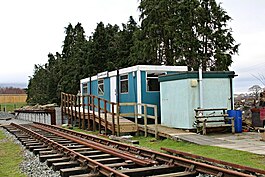
The Ffestiniog Railway is a heritage railway based on 1 ft 11+1⁄2 in narrow-gauge, located in Gwynedd, Wales. It is a major tourist attraction located mainly within the Snowdonia National Park.
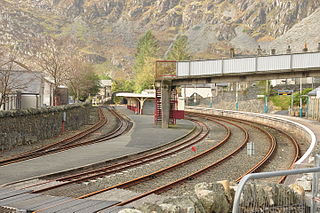
The Conwy Valley line is a railway line in north-west Wales. It runs from Llandudno via Llandudno Junction to Blaenau Ffestiniog, and was originally part of the London and North Western Railway, being opened in stages to 1879. The primary purpose of the line was to carry slate from the Ffestiniog quarries to a specially built quay at Deganwy for export by sea. The line also provided goods facilities for the market town of Llanrwst, and via the extensive facilities at Betws-y-Coed on the London to Holyhead A5 turnpike road it served many isolated communities in Snowdonia and also the developing tourist industry. Although only a little over 27 miles (43 km) between Llandudno and Blaenau Ffestiniog, the journey takes over one hour, largely due to the sinuous and steeply graded nature of the route taken. Most of the stations along the line are treated as request stops.

The Pontypool and Blaenavon Railway is a 3.5-mile (5.6 km) volunteer-run heritage railway in South Wales, running trains between a halt platform opposite the Whistle Inn public house southwards to the town of Blaenavon via a two-platform station at the site of former colliery furnace of the Big Pit National Coal Museum.
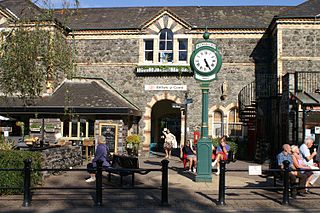
Betws-y-coed railway station is on the Conwy Valley Line, which runs between Llandudno and Blaenau Ffestiniog. It is situated 15+1⁄2 miles (24.9 km) south of Llandudno Junction.

Blaenau Ffestiniog railway station serves the slate mining town of Blaenau Ffestiniog, Wales, and is the passenger terminus of the Conwy Valley Line from Llandudno Junction. Transport for Wales Rail operate through services to Llandudno Junction and Llandudno. The station is a joint station with the narrow gauge Ffestiniog Railway, which operates primarily tourist passenger services to Porthmadog throughout most of the year. A feature of the standard gauge service is the availability on trains and buses of the popular "Gwynedd Red Rover" day ticket.

Dolgarrog railway station is an unstaffed halt, and a request stop, on the Conwy Valley Line from Llandudno Junction to Blaenau Ffestiniog.

Dolgarrog is a village and community in Conwy County Borough, in Wales, situated between Llanrwst and Conwy, very close to the Conwy River. The village is well known for its industrial history since the 18th century and the Eigiau dam disaster, which occurred in 1925. The population was 414 at the 2001 Census, increasing to 446 at the 2011 Census. The community extends up to, and includes part of, Llyn Cowlyd in the Carneddau.
The Bala and Festiniog Railway was a 4 ft 8+1⁄2 in, standard gauge, railway backed by the Great Western Railway (GWR) in north-west Wales. It connected Bala with Blaenau Ffestiniog.

Tan-y-Manod railway station was a railway station approximately 1 mile (1.6 km) south of Blaenau Ffestiniog, in Gwynedd, North Wales.
The Pontypool, Caerleon & Newport Railway was promoted independently to relieve congestion on the heavily worked Eastern Valley Line of the Monmouthshire Railway and Canal Company. The Great Western Railway put up half the capital, making it in effect a GWR subsidiary. It opened in 1874, and most long-distance passenger and goods traffic, especially the heavy mineral traffic, transferred to it. It amalgamated with the GWR in 1876.
The Anglesey Central Railway was a 17.5-mile (28.2 km) standard-gauge railway in Anglesey, Wales, connecting the port of Amlwch and the county town of Llangefni with the North Wales Coast Line at Gaerwen. Built as an independent railway, the railway opened in portions from 1864 to 1867. Due to financial troubles the railway was sold to the London and North Western Railway in 1876, which invested significantly in the infrastructure. Operation continued under various companies during the 20th century, but passenger services were withdrawn in 1964 as part of the Beeching Axe. Industrial freight services continued until 1993. The railway's tracks remain and local groups have demonstrated an interest in restoring services as a heritage railway. As of 2023, the middle 7 miles (11 km) from Llangefni station via Llangwyllog to Llannerch y Medd station have largely been cleared of vegetation, with a view to reopening.

The Eigiau Tramway might refer to the Eigiau Quarry Tramway or to the Eigiau Reservoir Tramway.

The Cowlyd Tramway was a 2 ft narrow gauge railway line used to convey men and materials to Llyn Cowlyd Reservoir, near Trefriw in northern Wales during the enlargement of the dam, and thereafter for maintenance purposes.
The Cedryn Quarry Tramway was an industrial narrow gauge railway that connected the slate quarries at Cedryn and Cwm Eigiau to the quays at Dolgarrog in the Conwy valley.
The Conway and Llanrwst Railway was a standard gauge railway built to connect the Welsh coastal town of Conway, nowadays addressed by its Welsh name of Conwy, with the inland towns of Llanrwst and Betws y Coed. It opened in 1863 and was eventually absorbed into the lines operated by the London and North Western Railway. In 2008 it continues to operate as part of the Conwy Valley Line.
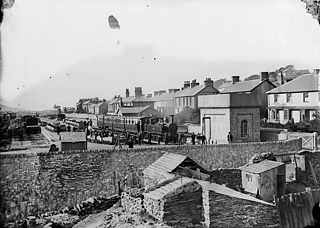
Nantlle was a railway station located in Talysarn, a neighbouring village to Nantlle, in Gwynedd, Wales.
Blaenau Festiniog Junction railway station was the Festiniog Railway (FR)'s third of eventually five passenger stations in Blaenau Ffestiniog, then in Merionethshire, now in Gwynedd, Wales.
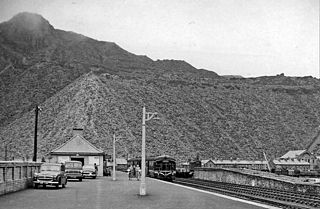
Blaenau Ffestiniog North was the London and North Western Railway's (LNWR's) second passenger station in Blaenau Ffestiniog, then in Merionethshire, now in Gwynedd, Wales.
The Llandudno branch line is a three-mile railway branch to the town from the main line at Llandudno Junction, Wales. It was opened in 1858, and it encouraged the development of the town as a tourist and holiday destination. Due to the popularity of the town, the station facilities at Llandudno station were progressively improved. Deganwy, on the branch line, was for some time a useful port.
Diphwys railway station was on the same site as the later Great Western Railway station in the heart of Blaenau Ffestiniog in what was then Merionethshire, now Gwynedd, Wales.
